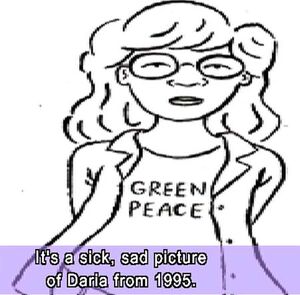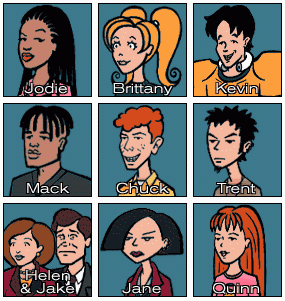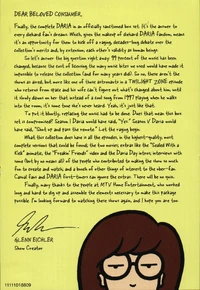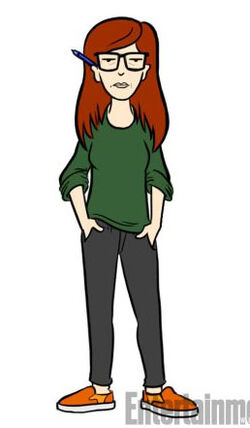Daria is an animated TV series about a young, intelligent, and cynical high school girl named Daria Morgendorffer, initially a supporting character on the MTV animated series Beavis and Butt-Head. It was produced by Tom Snyder Productions and MTV with Glenn Eichler who served as its executive producer and principal writer for the entire run of the series.
Peggy Nicoll and Anne D. Bernstein also served as major writers; the three writers listed wrote close to one-half of the episodes of the series. Daria would eventually be broadcast in at least thirty countries outside of the United States.
Series Running[]
The show ran on MTV for five seasons from March 3, 1997 to January 21, 2002. Glenn Eichler was given the option of half of a sixth season but he made the decision to conclude the series at the end of its fifth season. At four years and ten months, it became the longest-running animated series in MTV history, eclipsing the more popular Beavis and Butt-Head by a few months. (Daria would be the second-longest running MTV series if Celebrity Deathmatch is counted as an animated series.)
Daria on Beavis and Butt-Head[]
See also: Beavis and Butt-Head[]
Daria was the result of a production edict from MTV president Judy McGrath, that Beavis and Butt-Head needed at least one smart teen and female characters in it. The on-air promo department decided to merge the two demands and create a smart female foil that could tolerate the two eponymous leads. David Felton, with input from Mike Judge and John Andrews, created the character in the episode Scientific Stuff, her first appearance.
Daria Morgendorffer was voiced by Tracy Grandstaff, who would voice Daria in nineteen different episodes of Beavis and Butt-Head and all of the Daria episodes. Daria also appeared in most issues of the spin-off comic book, to which Glenn Eichler acted as a consultant. While her behavior and personality differs from that of Daria in several instances - she was more willing to volunteer for things, for example (see "Walkathon"), and some issues of the comic had her as a humorless know-all - her intelligence and outsider status was there from the start, and she would also show her sarcasm, craftiness, and mercenary streak in other episodes & issues.
Daria would appear in eleven episodes and eleven comics from 1993-94. During this time, MTV began to think about giving her a spin-off show of her own.
Development & Production[]

An early Daria character design, from the Complete Animated Series DVD
When Beavis and Butt-Head was in the latter half of its run on MTV, [- who wanted to bring more girls to the network - ordered MTV Animation to pitch cartoons for a female audience. Four original pilots would be created by outside creators.
MTV also asked Glenn Eichler, who worked on Beavis and Butt-Head, to create a spinoff series based around Daria. In an interview with The Onion AV Club, Beavis and Butt-Head creator Mike Judge said that MTV had mentioned the idea to him and he was surprised to find out they were doing it without his involvement, using some people he wasn't keen on (though he viewed Eichler as a good choice); he believes "I think they were trying to show that they could do something without me."
Production began in 1995. The initial designs, and the art style, were extremely different to the finished show. They were far more similar to Beavis and Butt-Head in look and tone: the characters had a 'muddier', more comically grotesque look to them. It was then decided to further seperate Daria from its parent show and to give it a clearer, simpler visual look, in order to appeal to potential female viewers that might have been turned off by the muddy, cluttered-line look of Beavis and Butt-Head. Karen Disher, Edward Artinian, and Willy Hartland were placed in charge of character design for the new show and refining the look. Susie Lewis added input to the character design, usually regarding character clothing and fashion.
A short animated pilot, Sealed with a Kick, was created by with Karen Disher as production designer and Sam Johnson and Chris Marcil as writers. The pilot was never aired and was never intended to be a completed cartoon. The animated characters are not colored, with different voices for main characters (like Kevin). Disher's designs of the main characters would further change between the time of "Sealed with a Kick" and the airing of the first new episode, and some parts of the characters were altered: Daria became less proactive in the series, for example.
On the Complete Animated Series DVD, Glenn Eichler says that developing the characters in the first seasons was "open season" and there wasn't as much planning "as people believe," with the show developing haphazardly. In the same feature, Anne D. Bernstein said the writers were left to develop "naturally", with little interference from MTV. In interviews with Kara Wild, Bernstein said she had to "make up a ton of stuff" about the Daria characters for the The Daria Diaries book as that type of background material hadn't been created beforehand (Peggy Nicoll would do the same for the second book. Eichler also stated in interview there wasn't much forward planning or grand arcs—for reasons of time and money, if they decided on a script, they had to produce it. For those same reasons, the Daria crew had to go to local drama schools and pick up first-time actors to fill out the voice-acting cast.

Jane's design from the same period.
Further development came near the end of the third season, when the Daria/Trent plot-line (a major part of the show) was ended and the character Tom Sloane was introduced, leading to Daria having a boyfriend during the fifth year. Eichler has stated that this major change was out of a desire to evolve Daria as a character by giving her a long-term relationship, "and of course it would provide us with some fresh story lines, always welcome after thirty-nine episodes." Tom was initially introduced as Jane's boyfriend, partly for the same reason of creating fresh story lines ("the situation would allow us to explore and test Daria and Jane's friendship").
| “ | I hope that gives you an indication as to how little planning of "season arcs" there actually was. | ” |
- Glenn Eichler, a 2006 interview
Production of each half-hour episode supposedly took ten months to a year, from concept to post-production. According to Glenn Eichler, all of the episodes for a season were roughly created and designed over the same time frame.
Karen Disher stated that the show deliberately eschewed odd camera angles or animation effects into order to concentrate on the expressions of the characters.
Many of the voice artist who provided voice talent for the episodes were found in New York. Tracy Grandstaff (Daria) had been a staff member for the MTV editorial department and had written for MTV as well as voiced characters other than Daria for Beavis and Butt-Head. Other actors had roles in local productions in New York City, or were found at high schools in the area, such as Jessica Cydnee Jackson (Jodie).
MTV Animation was the production company, and the design and storyboard work was done in the United States. At least during the first two seasons, Rough Draft Korea did 95 percent of the actual animation. Supposedly, one or two of the Season One episodes were done by Plus One Animation. In Season Three, animation of the episodes was placed back in control of Plus One Animation, although other episodes might have been done by Rough Draft Korea (or whoever could animate the episodes the most inexpensively). Both Rough Draft Korea and Plus One Animation are based in Korea.
Both Is It Fall Yet? and Is It College Yet? were animated by Plus One Animation.
Synopsis[]
Daria is the story of Daria Morgendorffer, an intelligent loner in the world of popularity obsessed teenagers who attend Lawndale High School.
Daria faces pressure on two fronts: from popular and shallow sister Quinn Morgendorffer and her parents—workaholic mother Helen Morgendorffer and father Jake Morgendorffer, a clueless man with an unfortunately short fuse. Daria's parents want her to be more popular and more outgoing, a path which Daria rejects.
It appears that Daria will be a loner at Lawndale until she meets a similar soul in the form of artist Jane Lane. Daria (and Jane) respond to the events around them with dry humor, wit, and sarcasm, comments which go over the heads of their targets.
Daria tries to avoid the machinations of both her parents and of Principal Angela Li, who wishes to draft Daria and her classmates into transparent money-making or promotional schemes designed to bring honor to Lawndale High School.
Daria, however, has people for whom she feels fondness other than Jane Lane. She finds herself attracted to Trent Lane, a tall dark and handsome (and lazy) musician and Jane's older brother. As the seasons progress, Daria's patience with Trent's laziness ends but for the first few seasons of Daria, Trent is Daria's secret crush.
The closeness of Daria's relationship with Jane is threatened by Jane's new boyfriend, Tom Sloane, whom Daria dislikes. Eventually, the two get used to each other and an attraction develops between the two. As Jane's relationship with Tom is failing, Daria and Tom become progressively more friendly until the two share a forbidden kiss in Tom's car. Daria tells Jane and the fallout nearly ends Daria's friendship with Jane, but somehow the friendship is repaired and Tom becomes Daria's boyfriend.
However, the Daria/Tom relationship is not meant to last, not surviving the final season. Daria breaks up with Tom in the final episode of the series, "Is It College Yet?" This episode has Daria and her classmates graduating Lawndale High School and going into separate ways. Daria and Jane will be going to separate colleges in the Boston area, ensuring that their very close friendship will last even after the end of the series.
Characters[]

Morgendorffer Family[]
- Daria Morgendorffer, the sarcastic protagonist. Daria is voiced by Tracy Grandstaff.
- Quinn Morgendorffer, Daria's attractive and popularity-obsessed sister. Quinn is voiced by Wendy Hoopes.
- Helen Morgendorffer, Daria's workaholic lawyer mother. Helen is also voiced by Wendy Hoopes.
- Jake Morgendorffer, the clueless head of the Morgendorffer household. Jake is voiced by Julian Rebolledo.
Lane Family[]
- Jane Lane, Daria's artistic best friend. Jane is voiced by Wendy Hoopes.
- Trent Lane, Jane's older brother whom Daria secretly likes. Trent is voiced by Alvaro J. Gonzalez.
- Amanda Lane, Jane's mother. Rarely present at the Lane household and consequently rarely featured on the series, Amanda is an unconventional artist and very laid back about the raising of her children.
- Vincent Lane, Jane's father. Like her mother Amanda, Vincent is rarely seen, frequently taking long trips to foreign countries for artistic purposes.
- Penny Lane, Jane and Trent's older sister, and presumed middle child of the Lane family, her name is a reference to the famous Beatles song.
- Summer Lane, Jane and Trent's older sister, and seemingly the eldest child of Amanda and Vincent.
- Wind Lane, Jane's eldest brother. Wind had been married and divorced three times (and, according to Jane in The Teachings of Don Jake, is soon to be remarried for a fourth time after trying to find out whether or not his three previous divorces were legalized in the U.S.)
Sloane family[]
- Tom Sloane, Jane's boyfriend and then Daria's for the final two seasons. Tom is voiced by Russell Hankin.
- Angier Sloane, Husband of Kay Sloane and father of Tom and Elsie Sloane.
- Kay Sloane, Wife of Angier Sloane and mother of Tom and Elsie Sloane. Kay appears only in the two Daria movies, Is It Fall Yet? and Is It College Yet? In the latter, she drives Tom and Daria to Bromwell and Raft College for their interviews.
- Elsie Sloane, Sister of Tom Sloane and the daughter of Angier and Kay Sloane.
Lawndale High[]
Faculty[]
- Angela Li, principal of Lawndale High School, obsessed with sports, high school security, and the glory of Lawndale High (and herself). Ms. Li is voiced by Nora Laudani.
- Mr. O'Neill, the wimpy English teacher at Lawndale. Mr. O'Neill is voiced by Marc Thompson.
- Anthony DeMartino, the rabid history teacher, doomed to be tormented by his ignorant students. Mr. DeMartino is also voiced by Marc Thompson.
- Janet Barch the psychotic, misandristic science teacher at Lawndale High. She was voiced by Ashley Albert
Students[]
- Brittany Taylor, the ditzy blonde who is head cheerleader at Lawndale High School. Brittany is voiced by Janie Mertz.
- Kevin Thompson, the quarterback at Lawndale High School who is even dumber. Kevin Thompson is voiced by Marc Thompson.
- Jodie Landon, a student who is not only smart, but outgoing in school activities. Jodie is voiced by Jessica Cydnee Jackson.
- Mack Mackenzie, Jodie's boyfriend, also on the football team. Mack has been voiced by: Delon Ferdinand, Paul Williams, Kevin Daniels, Amir Williams.
- Charles "Upchuck" Ruttheimer III, lecherous student at Lawndale, always hitting on the ladies. Upchuck was voiced by Marc Thompson (Season 1) and Geoffrey Arend (Seasons 2-5).
- Sandi Griffin, president of the Fashion Club, voiced by Janie Mertz
- Stacy Rowe, voiced by Sarah Drew, and
- Tiffany Blum-Deckler voiced by Ashley Albert.
- Andrea, the mysterious Goth loner. Andrea was voiced by Susie Lewis (Seasons 1-3) and Janie Mertz (Seasons 4 and 5).
Episodes[]
Daria ran on MTV from March 3, 1997 to January 20, 2002. It consisted of five seasons of thirteen episodes apiece, as well as two film-length episodes.
Initially, Daria premiered on MTV USA's popular "10 Spot" on Monday nights. Daria would remain on Monday nights for two seasons, then switch to Wednesday night at the beginning of the third season.
At the beginning of the fourth season, Daria was moved to Friday night, traditionally a poor night for television in the United States as Friday is the end of the work/school week and most people spend their evenings outside the home instead of watching TV. Daria was moved back onto Monday nights for its fifth and final season.
During the lifetime of the series, Daria was much more heavily promoted in its first three seasons than it its final two. Generally, episodes were rerun several times during the first three seasons whereas during the fifth season fans had to wait for marathons to take place in hopes of catching missed episodes, which were not rerun.
Web Presence on MTV USA[]
On the MTV USA web site, a section of the website was devoted to Daria. MTV currently maintains a Daria website, although it hasn't been updated in years. To promote the DVD release of Daria: The Complete Animated Series, MTV launched a new Daria website, featuring full video of season 1 episodes. The old Daria website remains on MTV.com.
All website material was written by Anne D. Bernstein.
New material on the website included interesting essays, in-character writing from the cast, and interesting facts not available from watching the show. For example, the full last names of Stacy and Tiffany were first revealed on the MTV Daria website on June 25, 1999. (An argument could be made that Tiffany's last name was revealed in "The Invitation," but the last name was not attributed to that character until the web site update.)
Annoyingly, the MTV Daria website did not archive its past material. When new content was added, old content would sometimes be removed. Old content can be occasionally found at by searching web archives or fandom sites.
Related Media[]
During Daria's run, the character became notable enough to be called in as a "host" or "narrator" for a number of MTV's shows and events, as well as to be "interviewed":
- MTV Video Music Awards 97 short animation featuring Daria (September 4, 1997) Transcript
- Daria called into MTV's 'Cool Crap Auction' Transcript
- Daria Day 98 marathon of Daria episodes on the date of the premiere of the second season (February 16, 1998), hosted by Daria and Jane. Transcript
- Daria Day 99 marathon of Daria episodes on February 15th, 1999 for the premiere episode of the third season, hosted by Daria and Jane.
- Daria and Jane hosted a Daria episode marathon titled Sarcastathon 3000 for the premiere episode of the fifth season Transcript
- Daria and Jane hosted an episode of 'MTV's Top 10'. Commenting on the top 10 animated music videos Transcript
- Behind the Scenes at Daria hosted by Janeane Garofalo. More behind the scenes clips aired in Daria episodes following the special.
- MTV's Toonumentary detailed the history and details of MTV's animated shows. Transcript
- MTV New Year's Eve 2002 event featured a short appearance by Daria (December 31, 2001).Transcript.
- Daria was interviewed on the CBS Early Show on January 21, 2002 Transcript
- 'Look Back in Annoyance' was a half-hour retrospective of the series. Hosted by Daria and Jane. Transcript
Reception, Impact on Viewers, and Legacy[]
The show was quickly found to be popular. In early 1998, The New York Times reported that Daria was one of MTV's highest rated shows, with the network's manager Van Toffler viewing her as "a good spokesperson for MTV, intelligent but subversive", and that MTV had found most audiences responded well to the character. (One of the few audiences that didn't were 18-24 year old males.) The investment company Ehrenkrantz King Nussbaum credited Daria and Beavis and Butt-Head as helping to fuel MTV's growth in the 1990s to a general entertainment network and to encourage other networks to make cartoons like South Park & King of the Hill. Teen Magazine readers voted Daria for the magazine's "Killer Cartoon" award in February 1999. In a later Times article spotlighting Is It Fall Yet?, MTV executive Abby Terkuhle attributed the success to how Daria "says things that most people just think"...and, from what his six-year-old daughter told him, because the characters "make fun of their parents."
Daria received positive reviews during its run. John J. O'Connor of The New York Times wrote of the series' premiere, "With this new series, Daria triumphantly gets the last laugh" and "As far as MTV and Beavis and Butt-Head are concerned, Daria is an indispensable blast of fresh air. I think I'm in love." Daria received a ratings share between 1 and 2 percent, about 1 to 2 million viewers. Kathy M. Newman wrote that, although Daria was "not a huge hit by network standards", it became "a signature show" for MTV: "intelligent and subversive—an unusual combination for prime time television." Anita Gates for the New York Times admitted, when giving the show a favourable review, that she wished she'd been Daria as a teenager.
When the show ended, G.J. Donnelly of TV Guide lamented, "I already miss that monotone. I already miss those boots. ... Even at its most far-fetched, this animated film approaches the teenage experience much more realistically than shows like Dawson's Creek." On the same occasion, Emily Nussbaum wrote at Slate that "the show is biting the dust without ever getting the credit it deserved: for social satire, witty writing, and most of all, for a truly original main character". She particularly singled out for praise that all the characters were heading "to very different paths in life, based on their economic prospects", giving the show an ambiguous end; "[the finale is] a bit of a classic: a sharply funny exploration of social class most teen films would render, well, cartoonish."
When the DVD came out, DVD Talk's review referred to the show as "an indictment of everything MTV now embraces", and praised the character development and how the show still held up. Slate magazine's Reiham Salan said that the show had irritated him as a high school student when it first debuted, disliking that "the popular kids were defenseless", but praises that as well as Daria and Jane developing over time, the "popular" and adult characters also became deeper and more developed, and that the characters Mack and Jodie showed "not all popular kids are vapid goons": the series ends up challenging and undermining its own (and ours) initial preconceptions of the cast.
During the show's run, one critic complained that the series was "particularly insidious" because it offered "a corrupt role model" for teenagers. Kathy Newman disputed that, saying that the Daria fandom was "refreshingly sincere" and optimistic. Rather than encouraging nihilism "the show has become a way for dealing with nihilism" and the fandom enabled alienated youths to bond with each other and express creativity.
In a 2010 review of the DVD collection in Jezebel, Margaret Hartmann said that at as a teenager, "Daria and her best friend Jane Lane provided me with the sort of social guidance that allowed me to stay true to myself" and led to her keeping a childhood friend instead of dropping her to avoid "social suicide": "I'd picked up [Daria's] attitude that it's easier to survive high school with one fellow-loser who shares your misanthropic views than to spend four years trying to earn the admiration of girls whose main interests include proper eyeliner application". She cites Daria as "the most authentic TV nerd... she didn't look for her fellow students to accept her. She just wanted to be left alone", and said TV lacks similar character that "painfully geeky girls can relate to."
The characters are still known well enough that Drawn Together could cameo Daria (albeit as an "unpopular" character) in one episode in 2007, and that Jezebel magazine could run an open letter from "Quinn" as an article in May 2010. Following the DVD release, Watsky & The GetBand would go on to use Daria as the set piece for A Love Story's music video, complete with some commentary from Daria; internet reviewer The Nostalgia Chick would compare Daria to the 90s film She's All That in a review of the latter, with Daria episode "Through a Lens Darkly" held up as better.
Internet reviewer Doug Walker, aka the Nostalgia Critic/That Guy With The Glasses has cited this show as his favorite TV program. He was conscious that this might seem "a really weird choice" since he doesn't often mention it in his content, but praises it for accurately reflecting high school and the students - "I knew these people, I grew up with these people" - as well as dealing with difficult teenage issues, reflecting the feel of the late 90s, and for showing that Daria's cynical attitude, while cathartic, was not always right. He also said that while he was worried it may have become dated, contemporary teenagers have told him that it hasn't and that "these people... are still around". He said that there were only three episodes he didn't like: Depth Takes a Holiday, Daria! and Life in the Past Lane, mainly for their irrelevancy.
2010 & Onward[]

DVD insert explaining the rights issues.
2010 saw the release of the DVD Daria: The Complete Animated Series in the US and Canada. A Region 4 release, primarily for Australia, would follow in 2011. For legal reasons, almost the entirety of the music cues had to be taken out and replaced with generic royalty-free replacements.
In promotion of the Region 1 DVD, MTV started a Daria Facebook page and aired reruns on MTV2 and LGBT channel Logo. (The show would later appear on Hulu too.) The show appeared to have done well for Logo, as repeats continued and were included in marathons. The Facebook page would go on to have hundreds of thousands of fans and in summer 2011, they started to hold caption contests and fanart competitions on it. The blog MTV Clutch would also flag up Daria.
NavTones would create a Daria GPS Voice in 2010, with Tracy Grandstaff reprising her role.

Daria in 2017, by Karen Disher
On August 8th 2011, online magazine Racked commissioned Glenn Eichler and Karen Disher to create the 'article' "Daria Morgendorffer's Greatest Retail Regret". This was the first time Eichler had written for the character since Is It College Yet?, with a tongue-in-cheek description as "her [Daria's] first public statement in many years". He returned to her again for February 14 2012, when "Daria" wrote "What I Think About Valentine's Day" for the Huffington Post.
October 2011 saw a thousand fan's fantasies come true, when MTV Shops began selling a Deluxe Daria Costume.
Beavis and Butt-Head would make its return to MTV in late 2011, and on July 29 the President for MTV Networks Music and Logo Group, Van Toffler, was asked about a potential return of Daria too. He said that the show had "done quite well" on MTV 2 and Logo, and because of that they'd talked to "the creators" about the chances of new Daria. "There's not as long-a-shot as you might think that Daria might be back on one of our channels". [3] However, in late October MTV executive Chris Linn told The Washington Post that there were currently no plans for new Daria, although this could change if the Beavis and Butt-Head revival was incredibly successful. [4]
At the NY Comic Con 2011, where Mike Judge said Daria would be getting a cameo in the first B&B season, that he liked the character a lot, and that "maybe" he should do more with her; MTV's Daria Facebook said this was "met with overwhelming applause." He later told New York Magazine "boy, I keep getting asked that [about Daria]", including by Quentin Tarantino. ("I didn’t expect the guy who made Reservoir Dogs to be a Daria fan") "I should do more Daria, I guess."

In 2013, College Humor created a trailer for a fake Daria movie. Aubrey Plaza was cast as an adult Daria, spinning off a 2011 'fantasy casting' puff piece by MTV.
Grandstaff, Eichler, and Lewis had all been asked in interviews where they felt the cast would have turned out. For the show's 20th anniversary, Entertainment Weekly had Lewis write up explicit status quos for the cast and had Karen Disher drew 2017 versions of them for "Catching Up with the Daria Gang". (Daria, as Grandstaff had believed should happen, was working on a comedy talk show just like Eichler had done.) Lewis admitted to Weekly that she'd had these thoughts in her had for a while. This is, so far, the most fleshed out 'post canon' idea and possibly the final word on the original continuity.
Aired to Other Countries[]
It was also broadcasted in Korea, where animations were made aired by Tooniverse from November 1998. Only Season 1 and Season 3(known as Season 2) episodes were broadcasted as subtitled version.
In Germany, It was broadcasted by MTV Germany since 1998 as original version. After 2001 dubbed version were aired too.
It was broadcasted it Switzerland from 2001 to 2002 by SF 2. 35 first episodes were dubbed. Also aired in Czech republic.
MTV Latin America and Spain were aired as dubbed version. Also Canal 5 in Mexico and Canal+ in Spain were broadcasted too.
See Also[]
- Daria's appearances in the Beavis and Butt-Head comics
- List of bloopers and goofs in Daria
- Datedness of Daria
- Daria Webring
External Links[]
- MTV USA's current Daria website
- MTV USA's former Daria website (still online but no longer updated)
